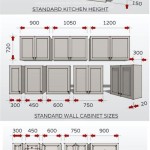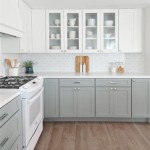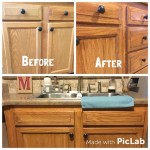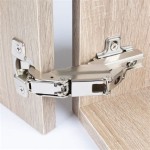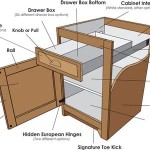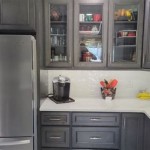Pictures Two Tone Painted Kitchen Cabinets: A Comprehensive Guide
Two-toned painted kitchen cabinets have experienced a significant resurgence in popularity, offering a customizable and visually appealing alternative to traditional, monolithic kitchen designs. This approach involves painting upper and lower cabinets in contrasting colors, creating depth, interest, and a personalized aesthetic. Selecting the right color combinations and understanding the practical considerations are essential to achieving a successful and enduring result. This article will explore various aspects of two-toned kitchen cabinets, providing insight into design principles, color choices, and implementation strategies.
Understanding the Appeal of Two-Tone Kitchen Cabinets
The enduring appeal of two-toned kitchen cabinets stems from several key advantages. First, the design offers a high degree of personalization, allowing homeowners to tailor the kitchen to their specific tastes and preferences. Unlike all-white or all-wood kitchens, a two-toned approach encourages creativity and the exploration of color palettes that reflect individual styles. Secondly, the contrasting colors can visually enhance the kitchen's architecture. Darker base cabinets can ground the space, while lighter upper cabinets can create an illusion of height and openness. This is particularly beneficial in smaller kitchens or those with lower ceilings. Thirdly, two-toned cabinets offer an opportunity to highlight specific areas or features within the kitchen. A contrasting color on the kitchen island, for example, can draw attention to this central hub and make it a focal point.
Furthermore, the two-toned design provides flexibility in managing wear and tear. Lower cabinets, which are more susceptible to scuffs and spills, can be painted in darker, more durable colors that conceal imperfections. Upper cabinets, which are less prone to damage, can be finished in lighter, more decorative hues. This strategic approach can extend the lifespan of the painted finish and reduce the need for frequent touch-ups. Finally, the two-toned look avoids the potential monotony of a single-color kitchen. The contrasting elements introduce visual interest and dynamism, preventing the space from feeling bland or sterile.
Selecting Complementary Color Combinations
Choosing the right color combination is critical to the success of a two-toned kitchen design. The selected colors should complement each other, the existing décor, and the overall architectural style of the home. A good starting point is to consider the color wheel and the principles of color theory. Complementary colors, located opposite each other on the color wheel (e.g., blue and orange, red and green), create high contrast and visual excitement. Analogous colors, which are adjacent to each other on the color wheel (e.g., blue, blue-green, and green), offer a more harmonious and subtle effect. Triadic color schemes, using three colors equally spaced on the color wheel, can create a balanced and vibrant look.
Beyond color theory, practical considerations are also important. The size and lighting of the kitchen should influence color choices. In smaller kitchens, lighter colors are generally preferred for both upper and lower cabinets to maximize light reflection and create a sense of spaciousness. Darker colors can be used strategically as accents or on the island to add depth and visual interest without overwhelming the space. In larger kitchens with ample natural light, the options are more diverse, and darker colors can be used more liberally. However, it is essential to maintain a balance to prevent the kitchen from feeling too dark or heavy.
Popular two-toned color combinations include: *
White and Gray:
This classic combination is versatile and timeless. White upper cabinets create a bright and airy feel, while gray lower cabinets add sophistication and grounding. *Navy Blue and White:
A nautical-inspired scheme that is both elegant and inviting. Navy blue lower cabinets provide a strong visual anchor, while white upper cabinets maintain a sense of lightness. *Sage Green and Cream:
A soft and calming combination that evokes a sense of nature and tranquility. Sage green lower cabinets blend seamlessly with the surrounding environment, while cream upper cabinets add warmth and subtle contrast. *Black and White:
A bold and dramatic combination that creates a striking visual impact. Black lower cabinets add a sophisticated and modern edge, while white upper cabinets provide a clean and crisp counterpoint. *Wood Tones and Painted Colors:
Combining natural wood finishes with painted cabinets can add warmth and texture to the kitchen. For example, natural oak lower cabinets paired with painted white or gray upper cabinets create a balanced and inviting space.It is advisable to test color samples in the actual kitchen environment before making a final decision. The lighting in the kitchen can significantly affect how the colors appear. Observe the samples under different lighting conditions, both natural and artificial, to ensure that the chosen colors achieve the desired effect. Paying attention to the undertones of the colors is also crucial. Undertones are subtle hues that can significantly impact the overall appearance of the color. For example, some grays have warm undertones (brown or beige), while others have cool undertones (blue or green). Ensure that the undertones of the chosen colors complement each other and the existing elements in the kitchen.
Implementing the Two-Tone Design Effectively
The successful implementation of a two-toned kitchen design requires careful planning and attention to detail. The first step is to determine which cabinets will be painted in which color. The most common approach is to paint the lower cabinets in a darker color and the upper cabinets in a lighter color. This creates a visual hierarchy and enhances the sense of height and spaciousness. However, there are other variations that can be equally effective. For example, the island can be painted in a contrasting color to create a focal point, or a single bank of cabinets can be painted in a different color to add a touch of drama.
The next step is to prepare the cabinets for painting. This involves cleaning, sanding, and priming the cabinets surfaces. Thorough cleaning removes any dirt, grease, or grime that could interfere with the adhesion of the paint. Sanding creates a slightly rough surface that provides a better grip for the primer. Priming seals the wood and prevents the paint from being absorbed unevenly. Using a high-quality primer is essential for achieving a smooth and durable finish. The choice of paint is also critical. Opt for a durable, washable paint that is specifically designed for kitchen cabinets. Acrylic latex paints are a popular choice due to their durability, ease of cleaning, and low VOC content. Oil-based paints offer excellent durability and a smooth finish, but they require more time to dry and emit stronger odors.
Consider the hardware when planning a two-toned kitchen. New hardware can significantly enhance the overall look and complement the chosen color scheme. Different finishes, such as brushed nickel, oil-rubbed bronze, or gold, can add a touch of elegance or modernity. The style of the hardware should also be consistent with the overall design aesthetic. Sleek, minimalist hardware complements contemporary kitchens, while more ornate hardware suits traditional kitchens. Ensure that the hardware matches the faucet and other metal fixtures in the kitchen to create a cohesive and unified look.
Pay close attention to the details, such as the edges and corners of the cabinets. These areas are prone to chipping and peeling, so it is essential to apply multiple coats of paint and ensure that each coat is fully dry before applying the next. Using painter's tape to create clean lines can also enhance the overall appearance of the cabinets. Remove the tape carefully after the paint has dried to avoid chipping or peeling. If you are uncertain about your painting skills, consider hiring a professional painter. A professional painter can ensure that the cabinets are properly prepared and painted, resulting in a smooth, durable, and long-lasting finish.
Furthermore, carefully consider the placement of appliances and accessories within the kitchen in relation to the two-toned cabinets. Stainless steel appliances, for example, can complement both light and dark cabinet colors, adding a touch of modern sophistication. Incorporating natural elements, such as wood countertops or open shelving, can also enhance the overall warmth and texture of the kitchen. Consider adding decorative accents, such as plants, artwork, or colorful dishes, to personalize the space and create a welcoming atmosphere. Coordinating the backsplash and countertops with the cabinet colors is also crucial. A neutral backsplash, such as white subway tile or light-colored stone, can provide a clean and timeless backdrop, while a bolder backsplash can add a pop of color and visual interest. Similarly, the countertops should complement the cabinets and provide a durable and practical surface for food preparation.

20 Two Toned Kitchen Cabinet Ideas
:strip_icc()/housesprucingtwotone-635e1f1e3437433aa69b091bd16e2e81.jpeg?strip=all)
30 Stylish Two Toned Kitchen Ideas From An Expert

Two Tone Kitchen Cabinets Will Reinsure Your Favorite Spot In The With It S Color Combination New Cabinet Colors

Two Toned Kitchen Cabinets Painting Your

About Two Tone Kitchen Cabinets Wolf Home S

Two Color Kitchen Cabinets Ideas And Exact Paint Matches Painted Colors Cabinet Modern White

Choosing The Right Paint Color For Kitchen Cabinets

Design Inspiration Tips For Two Tone Kitchen Cabinets Hirshfield S

Painting A Two Tone Kitchen Pictures Ideas From
:strip_icc()/goldalamodetwotoned-7898e45ce4004aec878721b187b98301.jpeg?strip=all)
30 Stylish Two Toned Kitchen Ideas From An Expert
Related Posts

